King of Jerusalem

The King of Jerusalem[1] was the supreme ruler of the Kingdom of Jerusalem, the Crusader state founded by Christian princes in 1099 when the First Crusade took the city.
Godfrey of Bouillon, the first ruler of the Kingdom of Jerusalem, himself refused the title of king, and instead chose the title "Defender of the Holy Sepulchre". Thus, the title of king was only introduced for his successor, King Baldwin I in 1100. The city of Jerusalem was lost in 1187, but the Kingdom of Jerusalem survived (also known as the "Second Kingdom of Jerusalem"), moving its capital to Acre in 1191. The city of Jerusalem was re-captured in the Sixth Crusade, during 1229–39 and 1241–44. The Kingdom of Jerusalem was finally dissolved with the fall of Acre and the end of the Crusades in the Holy Land in 1291.
After the Crusader States ceased to exist, the title of King of Jerusalem was claimed by a number of European noble houses descended from the kings of Cyprus or the kings of Naples. The (purely ceremonial) title of King of Jerusalem is currently used by Felipe VI of Spain. It was claimed by Otto von Habsburg as Habsburg pretender until his renunciation of all claims in 1958, and by the kings of Italy until 1946.
Kings of Jerusalem (1099–1291)
| King of Jerusalem | |
|---|---|
 Royal Coat of arms (13th century) | |
| Details | |
| First monarch | Godfrey of Bouillon |
| Last monarch | Henry II |
| Formation | 1099 |
| Abolition | 1291 |
| Residence | David's Tower |
| Appointer | Hereditary Election |
| Pretender(s) | See Claimant |
The Kingdom of Jerusalem had its origins in the First Crusade, when Godfrey of Bouillon, after refusing a crown and the title of King "upon the plea that he would never wear a crown of gold where his Saviour had worn a crown of thorns",[2] took the title Advocatus Sancti Sepulchri (Protector of the Holy Sepulcher) in 1099 and was inaugurated as ruler of Jerusalem in the Church of the Nativity in Bethlehem.
The following year, his brother Baldwin I was the first to use the title king and the first to be crowned king in the Church of the Holy Sepulchre in Jerusalem itself.
The kingship of Jerusalem was partially elected and partially hereditary. During the height of the kingdom in the mid-12th century there was a royal family and a relatively clear line of succession. Nevertheless, the king was elected, or at least recognized, by the Haute Cour. Here the king was considered a primus inter pares (first among equals), and in his absence his duties were performed by his seneschal.
The purpose-built royal palace used from the 1160s onwards was located south of Jerusalem's citadel.[3] The Kingdom of Jerusalem introduced French feudal structures to the Levant. The king personally held several fiefs incorporated into the royal domain, that varied from king to king. He was also responsible for leading the kingdom into battle, although this duty could be passed to a constable.
While several contemporary European states were moving towards centralized monarchies, the king of Jerusalem was continually losing power to the strongest of his barons. This was partially due to the young age of many of the kings, and the frequency of regents from the ranks of the nobles.
After the fall of Jerusalem in 1187, the capital of the kingdom was moved to Acre, where it remained until 1291, although coronations took place in Tyre.
In this period the kingship was often simply a nominal position, held by a European ruler who never actually lived in Acre. When young Conrad III was king and living in Southern Germany, his father's second cousin, Hugh of Brienne, claimed the regency of the Kingdom of Jerusalem and, indirectly, his place in the succession. The claim was made in 1264 as senior descendant and rightful heir of Alice of Champagne, second daughter of Queen Isabella I, Hugh being the son of their eldest daughter. But was passed over by the Haute Cour in favour of his cousin, Hugh of Antioch, the future Hugh III of Cyprus and Hugh I of Jerusalem.
After Conrad III's execution by Charles I of Sicily in 1268, the kingship was held by the Lusignan family, who were simultaneously kings of Cyprus. However, Charles I of Sicily purchased the rights of one of the heirs of the kingdom in 1277.
In that year, he sent Roger of Sanseverino to the East as his bailiff. Roger captured Acre and obtained a forced homage from the barons. Roger was recalled in 1282 due to the Sicilian Vespers and left Odo Poilechien in his place to rule. His resources and authority was minimal, and he was ejected by Henry II of Cyprus when he arrived from Cyprus for his coronation as King of Jerusalem.
Acre was captured by the Mamluks in 1291, eliminating the crusader presence on the mainland.
Kings
House of Boulogne (1099-1118)
| Monarch | Image | Birth | Marriages | Death |
|---|---|---|---|---|
| Godfrey (Protector of the Holy Sepulchre, but not King)[2] 1099–1100 |
 |
c. 1060 Boulogne-sur-Mer, France or Baisy, Brabant son of Eustace II, Count of Boulogne and Ida of Lorraine |
never married | 18 July 1100 aged about 40 |
| Baldwin I 1100–1118 |
 |
c. 1058 Lorraine, France son of Eustace II, Count of Boulogne and Ida of Lorraine |
Godehilde de Toeni no children Arda of Armenia 1097 no children Adelaide del Vasto 1112 no children |
2 April 1118 Al-Arish, Egypt aged about 60 |
House of Rethel (1118-1153)
| Monarch | Image | Birth | Marriages | Death |
|---|---|---|---|---|
| Baldwin II 1118–1131 |
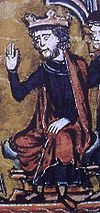 |
?? France son of Hugh I, Count of Rethel and Melisende of Montlhéry |
Morphia of Melitene 1101 four daughters |
21 August 1131 Jerusalem |
| Melisende 1131–1153 with Fulk until 1143 with Baldwin III from 1143 |
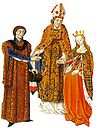 |
1105 Jerusalem daughter of King Baldwin II and Morphia of Melitene |
Fulk V, Count of Anjou 2 June 1129 2 sons |
11 September 1161 Jerusalem aged 56 |
House of Anjou (1153-1205)
In 1127 Fulk V, Count of Anjou received an embassy from King Baldwin II of Jerusalem. Baldwin II had no male heirs but had already designated his daughter Melisende to succeed him. Baldwin II wanted to safeguard his daughter's inheritance by marrying her to a powerful lord. Fulk was a wealthy crusader and experienced military commander, and a widower. His experience in the field would prove invaluable in a frontier state always in the grip of war.
However, Fulk held out for better terms than mere consort of the Queen; he wanted to be king alongside Melisende. Baldwin II, reflecting on Fulk's fortune and military exploits, acquiesced. Fulk then resigned his titles to Geoffrey and sailed to become King of Jerusalem, where he married Melisende on 2 June 1129. Later Baldwin II bolstered Melisende's position in the kingdom by making her sole guardian of her son by Fulk, Baldwin III, born in 1130.
Fulk and Melisende became joint rulers of Jerusalem in 1131 with Baldwin II's death. From the start Fulk assumed sole control of the government, excluding Melisende altogether. He favored fellow countrymen from Anjou to the native nobility. The other crusader states to the north feared that Fulk would attempt to impose the suzerainty of Jerusalem over them, as Baldwin II had done; but as Fulk was far less powerful than his deceased father-in-law, the northern states rejected his authority.
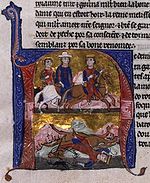
In Jerusalem as well, Fulk was resented by the second generation of Jerusalem Christians who had grown up there since the First Crusade. These "natives" focused on Melisende's cousin, the popular Hugh II of Le Puiset, count of Jaffa, who was devotedly loyal to the Queen. Fulk saw Hugh as a rival, and in 1134, in order to expose Hugh, accused him of infidelity with Melisende. Hugh rebelled in protest and secured himself to Jaffa, allying himself with the Muslims of Ascalon. He was able to defeat the army set against him by Fulk, but this situation could not hold. The Patriarch interceded in the conflict, perhaps at the behest of Melisende. Fulk agreed to peace and Hugh was exiled from the kingdom for three years, a lenient sentence.
However, an assassination attempt was made against Hugh. Fulk, or his supporters, were commonly believed responsible, though direct proof never surfaced. The scandal was all that was needed for the queen's party to take over the government in what amounted to a palace coup. Author and historian Bernard Hamilton wrote that the Fulk's supporters "went in terror of their lives" in the palace. Contemporary author and historian William of Tyre wrote of Fulk "he never attempted to take the initiative, even in trivial matters, without (Melisende's) consent". The result was that Melisende held direct and unquestioned control over the government from 1136 onwards. Sometime before 1136 Fulk reconciled with his wife, and a second son, Amalric was born.
In 1143, while the king and queen were on holiday in Acre, Fulk was killed in a hunting accident. His horse stumbled, fell, and Fulk's skull was crushed by the saddle, "and his brains gushed forth from both ears and nostrils", as William of Tyre describes. He was carried back to Acre, where he lay unconscious for three days before he died. He was buried in the Church of the Holy Sepulchre in Jerusalem. Though their marriage started in conflict, Melisende mourned for him privately as well as publicly. Fulk was survived by his son Geoffrey of Anjou by his first wife, and Baldwin III and Amalric I by Melisende.
Baldwin III ascended the throne with his mother as co-ruler, in 1143. His early reign was laced with squabbles with his mother over the possession of Jerusalem, till 1153, when he took personal hold of the government. He died in 1163, without heirs, and the kingdom passed to his brother, Amalric I, although there was some opposition among the nobility to Amalric's wife Agnes; they were willing to accept the marriage in 1157 when Baldwin III was still capable of siring an heir, but now the Haute Cour refused to endorse Amalric as king unless his marriage to Agnes was annulled. The hostility to Agnes, it must be admitted, may be exaggerated by the chronicler William of Tyre, whom she prevented from becoming Latin Patriarch of Jerusalem decades later, as well as from William's continuators like Ernoul, who hints at a slight on her moral character: "car telle n'est que roine doie iestre di si haute cite comme de Jherusalem" ("there should not be such a queen for so holy a city as Jerusalem").
Nevertheless, consanguinity was enough for the opposition. Amalric agreed and ascended the throne without a wife, although Agnes continued to hold the title Countess of Jaffa and Ascalon and received a pension from that fief's income. The church ruled that Amalric and Agnes' children were legitimate and preserved their place in the order of succession. Through her children Agnes would exert much influence in Jerusalem for almost 20 years. Almaric was succeeded by his son by Agnes, Baldwin IV.
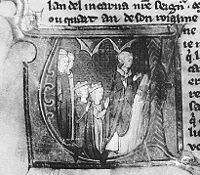
Almaric's wives, Agnes of Courtenay, now married to Reginald of Sidon, and Maria Comnena, the dowager Queen, who had married Balian of Ibelin in 1177. His daughter by Agnes, Sibylla, was already of age, the mother of a son, and was clearly in a strong position to succeed her brother, but Maria's daughter Isabella had the support of her stepfather's family, the Ibelins.
In 1179, Baldwin began planning to marry Sibylla to Hugh III of Burgundy, but by spring 1180 this was still unresolved. Raymond III of Tripoli attempted a coup, and began to march on Jerusalem with Bohemund III, to force the king to marry his sister to a local candidate of his own choosing, probably Baldwin of Ibelin, Balian's older brother. To counter this, the king hastily arranged her marriage to Guy of Lusignan, younger brother of Amalric, the constable of the kingdom. A foreign match was essential to bring the possibility of external military aid to the kingdom. With the new French king Philip II a minor, Guy's status as a vassal of the King and Sibylla's first cousin Henry II of England - who owed the Pope a penitential pilgrimage - was useful.

By 1182, Baldwin IV, increasingly incapacitated by his leprosy, named Guy as bailli. Raymond contested this, but when Guy fell out of favour with Baldwin the following year, he was re-appointed bailli and was given possession of Beirut. Baldwin came to an agreement with Raymond and the Haute Cour to make Baldwin of Montferrat, Sibylla's son by her first marriage, his heir, before Sibylla and Guy. The child was crowned co-king as Baldwin V in 1183 in a ceremony presided by Raymond. It was agreed that, should the boy die during his minority, the regency would pass to "the most rightful heirs" until his kinsmen - the Kings of England and France and Frederick I, Holy Roman Emperor - and the Pope were able to adjudicate between the claims of Sibylla and Isabella. These "most rightful heirs" were not named.
Baldwin IV died in spring 1185, and was succeeded by his nephew. Raymond was bailli, but he had passed Baldwin V's personal guardianship to Joscelin III of Edessa, his maternal great-uncle, claiming that he did not wish to attract suspicion if the child, who does not seem to have been robust, were to die. Baldwin V died during the summer of 1186, at Acre. Neither side paid any heed to Baldwin IV's will.
After the funeral, Joscelin had Sibylla named as her brother's successor, although she had to agree to divorce Guy, just as her father had divorced her mother, with the guarantee that she would be allowed to choose a new consort. Once crowned, she immediately crowned Guy. Meanwhile, Raymond had gone to Nablus, home of Balian and Maria, and summoned all those nobles loyal to Princess Isabella and the Ibelins. Raymond wanted instead to have her and her husband Humphrey IV of Toron crowned. However, Humphrey, whose stepfather Raynald of Châtillon was an ally of Guy, deserted him and swore allegiance to Guy and Sibylla.
| Monarch | Image | Birth | Marriages | Death |
|---|---|---|---|---|
| Fulk 1131–1143 with Melisende |
 |
1089/1092 Angers, France son of Fulk IV, Count of Anjou and Bertrade de Montfort |
Ermengarde of Maine 1109 4 children Melisende of Jerusalem 2 June 1129 2 sons |
13 November 1143 Acre, Kingdom of Jerusalem aged about 52 |
| Baldwin III 1143–1163 with Melisende until 1153 |
 |
1130 son of King Fulk and Queen Melisende |
Theodora Komnene 1158 no children |
10 February 1163 Beirut, Kingdom of Jerusalem aged 33 |
| Amalric I 1163–1174 |
 |
1136 son of King Fulk and Queen Melisende |
Agnes of Courtenay 1157 3 children Maria Komnene 29 August 1167 2 children |
11 July 1174 Jerusalem aged 38 |
| Baldwin IV the Leprous 1174–1185 with Baldwin V from 1183 |
 |
1161 Jerusalem son of King Amalric and Agnes of Courtenay |
never married | 16 March 1185 Jerusalem aged 24 |
| Baldwin V 1183–1186 with Baldwin IV until 1185 |
 |
1177 son of William of Montferrat and Sibylla of Jerusalem |
never married | August 1186 Acre, Kingdom of Jerusalem aged 9 |
| Sibylla 1186–1190 with Guy |
 |
c. 1157 daughter of King Amalric and Agnes of Courtenay |
William of Montferrat, Count of Jaffa and Ascalon 1176 one son Guy of Lusignan April 1180 2 daughters |
25 July (probable), 1190 Acre, Kingdom of Jerusalem aged about 40 |
| Guy of Lusignan 1186–1190/1192 with Sibylla until 1190 |
 |
c. 1150 or 1159/1160 son of Hugh VIII of Lusignan and Bourgogne de Rançon |
Sibylla of Jerusalem April 1180 2 daughters |
18 July 1194 Nicosia, Cyprus aged about 45 |
| Isabella I 1190/1192-1205 with Conrad until 1192 with Henry I 1192–1197 with Amalric II from 1198 |
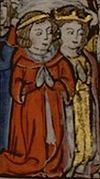 |
1172 Nablus, Kingdom of Jerusalem daughter of King Amalric I and Maria Komnene |
Humphrey IV of Toron November 1183 no children Conrad of Montferrat 24 November 1190 one daughter Henry II, Count of Champagne 6 May 1192 2 daughters Amalric of Lusignan January 1198 3 children |
5 April 1205 Acre, Kingdom of Jerusalem aged 33 |
| Conrad I of Montferrat 1190/1192–1192 with Isabella I |
mid-1140s Montferrat, Holy Roman Empire son of William V, Marquess of Montferrat and Judith of Babenberg |
unidentified woman before 1179 no children Theodora Angelina 1186/1187 no children Isabella I of Jerusalem 24 November 1190 one daughter |
28 April 1192 (murdered) Acre, Kingdom of Jerusalem aged mid-40s | |
| Henry I of Champagne 1192–1197 with Isabella I |
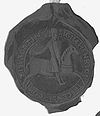 |
29 July 1166 Champagne son of Henry I, Count of Champagne and Marie of France |
Isabella I of Jerusalem 6 May 1192 2 daughters |
10 September 1197 Acre, Kingdom of Jerusalem aged 31 |
| Amalric II of Lusignan 1198–1205 with Isabella I |
- | 1145 son of Hugh VIII of Lusignan and Bourgogne de Rançon |
Éschive d'Ibelin before 29 October 1174 6 children Isabella I of Jerusalem January 1198 3 children |
1 April 1205 Acre, Kingdom of Jerusalem aged 60 |
| Monarch | Image | Birth | Marriages | Death |
|---|---|---|---|---|
| Maria 1205–1212 with John I from 1210 |
 |
1192 daughter of Conrad of Montferrat and Queen Isabella |
John of Brienne 14 September 1210 one daughter |
1212 aged 20 |
| John I 1210–1212 with Maria |
c. 1170 son of Erard II of Brienne and Agnes de Montfaucon |
Maria of Jerusalem 14 September 1210 one daughter Stephanie of Armenia one son Berengaria of León 1224 4 children |
27 March 1237 aged about 67 | |
| Isabella II also called Yolande 1212–1228 with Frederick from 1225 |
 |
1212 daughter of John of Brienne and Queen Maria |
Frederick II, Holy Roman Emperor 9 November 1225 2 children |
25 April 1228 Andria, Holy Roman Empire aged 16 |
| Frederick 1225–1228 with Isabella II |
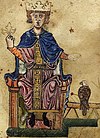 |
1194 son of Henry VI, Holy Roman Emperor and Constance of Sicily |
Constance of Aragon 15 August 1209 one son Isabella II of Jerusalem 9 November 1225 2 children Isabella of England 15 July 1235 4 children |
13 December 1250 Apulia, Holy Roman Empire aged 55 |
House of Hohenstaufen (1228-1268)
| Monarch | Image | Birth | Marriages | Death |
|---|---|---|---|---|
| Conrad II 1228–1254 |
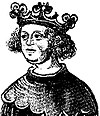 |
25 April 1228 Andria, Holy Roman Empire son of Frederick II, Holy Roman Emperor and Queen Isabella II |
Elisabeth of Bavaria 1 September 1246 one son |
21 May 1254 Lavello, Holy Roman Empire aged 26 |
| Conrad III 1254–1268 |
 |
25 March 1252 Wolfstein Castle, Landshut, Bavaria son of King Conrad II and Elisabeth of Bavaria |
never married | 29 October 1268 Castel dell'Ovo, Naples aged 16 |
House of Lusignan (1268-1291)
| Monarch | Image | Birth | Marriages | Death |
|---|---|---|---|---|
| Hugh 1268–1284 |
File:GM hugues3-1.jpg | 1235 son of Henry of Antioch and Isabella of Cyprus,a granddaughter of Queen Isabella I |
Isabella of Ibelin after 25 January 1255 11 children |
24 March 1284 Nicosia, Cyprus aged 49 |
| John II 1284–1285 |
- | 1259/1267 son of King Hugh and Isabella of Ibelin |
never married | 20 May 1285 Nicosia, Cyprus aged 17 or 26 |
| Henry II 1285–1324 in title only after 1291 |
- | 1271 son of King Hugh and Isabella of Ibelin |
Constanza of Sicily 16 October 1317 no children |
31 August 1324 Strovolos, Cyprus aged 53 |
Regents
The frequent absence or minority of monarchs required regents to be appointed many times throughout the Kingdom's existence.
| Regent | Regent for | Relation to the monarch | Became regent | Regency ended |
|---|---|---|---|---|
| Eustace Grenier, Constable of the Kingdom | Baldwin II | - | 1123 King held captive by the Ortoqids |
1123 death |
| William I of Bures, Prince of Galilee | - | 1123 King held captive by the Ortoqids |
1124 return of the King from captivity | |
| Queen Melisende | Baldwin III | mother | 1154 as the King's advisor |
1161 death |
| Raymond III, Count of Tripoli | Baldwin IV | cousin | 1174 minority of the King |
1176 majority of the King |
| Guy of Lusignan | brother-in-law | 1182 appointed by the King in his illness |
1184 deposed by the King | |
| Raymond III, Count of Tripoli | Baldwin V | first cousin once removed | 1185 minority of the King |
1186 death of the King |
| John of Ibelin, the Old Lord of Beirut | Maria | half-uncle | 1205 minority of the Queen |
1210 majority of the Queen |
| King John I | Isabella II | father | 1212 minority of the Queen |
1225 the Queen's marriage |
| Frederick II, Holy Roman Emperor | Conrad II | father | 1228 minority of the King |
1243 majority of the king |
| Alice of Champagne, Queen of Cyprus | half-aunt | 1243 absence of the king |
1246 death | |
| Henry I of Cyprus | half-cousin | 1246 absence of the King |
1253 death | |
| Plaisance of Antioch, dowager Queen of Cyprus | half-cousin-in-law | 1253 absence/minority of the King |
1261 death | |
| Conrad III | half-cousin-in-law once removed | |||
| Isabella of Antioch | half-cousin once removed | 1261 minority of the King |
1264 death | |
| Hugh of Antioch | half-second cousin | 1264 minority of the King |
1268 death of the King, ascension to the throne |
Claimant kings of Jerusalem (1291 until today)
Origins of the claims
Over the years, many European rulers claimed to be the rightful heirs to one of these claims. None of these claimants, however, has actually ruled over any part of the kingdom:
- Count Hugh of Brienne claimed the regency of the Kingdom of Jerusalem, and indirectly, his place in the succession in 1264 as senior heir of Alice of Jerusalem, second daughter of Queen Isabella I, and Hugh I of Cyprus. Hugh, being the son of their eldest daughter, was passed over by the Haute Cour in favour of his cousin Hugh of Antioch, the future Hugh III of Cyprus and Hugh I of Jerusalem. The Brienne claim to the Kingdom of Jerusalem continued, but the family had afterwards next to no part in affairs in Outremer.
- After the end of the kingdom, Henry II of Cyprus continued to use the title of King of Jerusalem. After his death the title was claimed by his successors, the kings of Cyprus.
- The title was also continuously used by the Angevin kings of Naples, whose founder, Charles of Anjou, had in 1277 bought a claim to the throne from Mary of Antioch. Thereafter, this claim to the Kingdom of Jerusalem was treated as a tributary of the crown of Naples, which often changed hands by testament or conquest rather than direct inheritance. As Naples was a papal fief, the Popes often endorsed the title of King of Jerusalem as well as of Naples, and the history of these claims is that of the Neapolitan Kingdom.
Potential claimants today
There are several potential[clarification needed] claimants of the title today.
- The title is in de facto use by the Spanish Crown, currently held by Felipe VI of Spain,
- Karl von Habsburg, current head of the House of Habsburg-Lorraine; Karl's father Otto von Habsburg has renounced all pretense to the Habsburg titles in 1958.
- Victor Emmanuel, Prince of Naples, pretender to the royal throne of Italy (House of Savoy)[citation needed]
- Amedeo, 5th Duke of Aosta, pretender to the royal throne of Italy (House of Savoy-Aosta)[citation needed]
- Prince Pedro, Duke of Calabria, pretender to the royal throne of Two Sicilies (House of Bourbon-Two Sicilies Calabria line)[citation needed]
- Prince Carlo, Duke of Castro, pretender to the royal throne of Two Sicilies (House of Bourbon-Two Sicilies Castro line)[citation needed]
- Charles-Antoine Lamoral, prince de Ligne de La Trémoïlle, heir-general of Yolande-Louise of Savoy and the Brienne claims[citation needed]
Lines of succession in several claims
Italics indicate individuals who did not themselves use the title of king of Jerusalem.
Cypriot claimants
- Henry II (1285) 1291–1324
- Hugh 1324–1359
- Peter I 1359–1369
- Peter II 1369–1382
- James I 1382–1398
- Janus 1398–1432
- John 1432–1458
- Charlotte I 1458–1485 (d. 1487) m. 1459 her cousin Louis of Savoy (d. 1482). In 1460, Charlotte was dispossessed of Cyprus by her illegitimate half-brother James. However, she maintained her claims until 1485, when she resigned them to the next legitimate heir, her 1st cousin once removed Charles I of Savoy (son of her first cousin Amadeus IX of Savoy).
|
House of Savoy: Savoyard claimants, heirs of Charlotte
|
House of Lusignan: Lusignan claimants and kings of Cyprus descended in the male line:
|
On the death of Charles II of Savoy, the Duchy of Savoy passed to his grand uncle and heir-male Philip (brother of Amadeus IX of Savoy). Although Charles II's sister Yolande Louise of Savoy did not succeed in Savoy because of her gender, she was the heir general of his brother and as such might be regarded to have succeeded him in claims to Cyprus and Jerusalem.
The Dukes of Savoy continued to claim Jerusalem. However, to avoid conflicts with claims of the major European houses as the Habsburg and Bourbons, the Savoyard claim appears hidden in the list of titles with the elliptical "&c."[4]
The direct line of the Lusignan kings continued in Constantinople with Prince Christodule de Lusignan in the 18th century, and later in Russia. Prince Louis de Lusignan arrived in Russia in 1827 and was matriculated in the nobility of the Russian Empire by Czar Nicholas I and accorded the title "Royal Prince of Cyprus, Jerusalem and Armenia"[7]. His son Prince Michel de Lusignan defended his titles before the French civil tribunals in the 1880s. The current representative of this line is the reigning Prince Constantine de Lusignan.[9]
|
Issue of Philip II of Savoy
|
Issue of Amadeus IX of Savoy
|
Neapolitan claimants
Mary of Antioch claimed the throne of Jerusalem from 1269 to 1277. She was the daughter of Prince Bohemond IV of Antioch and his second wife Melisende of Cyprus. Melisende was the youngest daughter of Isabella, Queen of Jerusalem and her fourth husband, Amalric II of Jerusalem, king of Cyprus.
Since Mary was, at the time of the death of Conrad III (Conradin), the only living grandchild of queen Isabella, she claimed the throne on basis of proximity in blood to the kings of Jerusalem. Denied by the Haute Cour, she went to Rome and sold her rights, with papal blessing and confirmation, to Charles of Anjou in 1277.
Thereafter, this claim to the kingdom of Jerusalem was treated also as tributary to the crown of Naples, which often changed hands by testament or conquest rather than direct inheritance.
- Charles I of Sicily 1277–1285; acquired title with approval of the Pope in 1277
- Charles II of Naples 1285–1309
- Robert of Naples 1309–1343, third but eldest surviving son, who succeeded in Naples superseding the rights of his eldest brother's heirs
- Joan I of Naples 1343–1382. Joan left her kingdom by testament to Louis I of Anjou, whom she had previously adopted as heir, but she was ousted and soon murdered by Charles of Durazzo, the heir male of her house.
|
House of Anjou-Sicily: Senior Angevin claimants :
|
House of Valois-Anjou: Junior Angevin claimants : |
|
House of Anjou-Hungary: Senior Angevin claimant :
|
- René I 1434–1480. René I united the claims of junior and senior lines. However, in 1441, control of the Kingdom of Naples was lost to Alfonso V of Aragon, who also claimed the kingdom of Jerusalem thereby.
| While René was succeeded in Bar by his grandson René of Vaudemont, René's nephew and heir male Charles IV of Anjou claimed the kingdoms of Sicily and Jerusalem, and he then testamented them to his cousin Louis XI of France. |
Aragonese claimants:
| ||||
|
Angevin-Lorraine claimants : House of Valois-Anjou
|
French claimants: House of Valois-Anjou
|
| |||
|
Spanish Bourbon claimant :
|
Habsburg claimant :
Two Sicilies claimants :
| ||||
|
Senior line :
|
Junior line :
| ||||
Brienne claims
- Hugh of Brienne and his heirs represent the senior heirs-general to the Kingdom, although they never pressed the claim after Hugh's rejection by the Haute Cour. In 1672, the succession of Brienne and of Cyprus to the crown of Jerusalem united.
Other historic claims
- Frederick of Meissen, Landgrave of Thuringia, briefly used the title after the death of Conradin in 1268, as grandson of Frederick II, who had crowned himself King of Jerusalem in his own right. This claim was never recognized in Outremer or elsewhere.
- According to E.P. Karnovich (1886),[7] Prince Louis de Lusignan reached the rank of colonel in the Russian service, and was granted by Tsar Nicholas I the title Prince of Cyprus, Jerusalem and Armenia. He claimed to be descended from Christobul de Lusignan, who had served in the Greek army under the Byzantine empire and was descended from the Cypriot House of Lusignan who'd moved to Egypt, Constantinople and onwards to St. Petersburg. Tsar Nicholas I allowed Colonel Lusignan to be matriculated as a Russian noble, that is a person holding an office which ennobled him.[8] The colonel was probably known as Louis Christian de Lusignan.[9]
References
- ^ Guy. 2012. Encyclopædia Britannica Online. Retrieved 27 August 2012, from http://www.britannica.com/EBchecked/topic/249989/Guy
- ^ a b Whitworth Porter (2013). A History of the Knights of Malta. Cambridge Library Collection - European History. Cambridge University Press. p. 18. ISBN 9781108066228. Retrieved 20 May 2014.
Refusing the title of King and the diadem which were offered him, upon the plea that he would never wear a crown of gold where his Saviour had worn a crown of thorns, he modestly contented him with the title of Defender and Advocate of the Holy Sepulchre.
{{cite book}}: External link in|series= - ^ Adrian J. Boas. Jerusalem in the Time of the Crusades: Society, Landscape and Art in the Holy City under Frankish Rule. Pages 79-82. Routledge 2009. ISBN 9780415488754. [1]
- ^ Scott, John Beldon (2003) Architecture for the shroud: relic and ritual in Turin, University of Chicago Press
- ^ Catalogue of additions to the manuscripts - British Museum. Dept. of Manuscripts - Google Libros. Books.google.es. Retrieved 27 November 2012.
- ^ The ... history of the feats, gests, and prowesses of the chevalier Bayard ... - Jacques de Mailles - Google Libros. Books.google.es. Retrieved 27 November 2012.
- ^ Evgenii Petrovich Karnovich (1823-1885) Rodovye prozvaniya I tituly v Rossii (Family Names and Titles in Russia) St Peterburg 1886
- ^ Cecil R. Humphery-Smith, Princes of Lusignan page 5 The Institute of Heraldic and Genealogical Studies 2004.
- ^ In the issue No. 180 of the Peterburgskiy Listok (Petersburg List) Newspaper July 3–15, 1884, a list of deceased in St Petersburg between 11 June and 18 June was found. There was a record for Louis Christian de Lusignan, colonel (retired). In the same newspaper issue No. 172 25 June - 7 July 1884, the following article was published: "The deceased who was buried thereby on Smolensk graveyard on 23 July, was a titled King of Cyprus and Jerusalem and Armenia, descendant of one of the protector of God's Casket, colonel of the Russian service, Louis de Lusignan."
